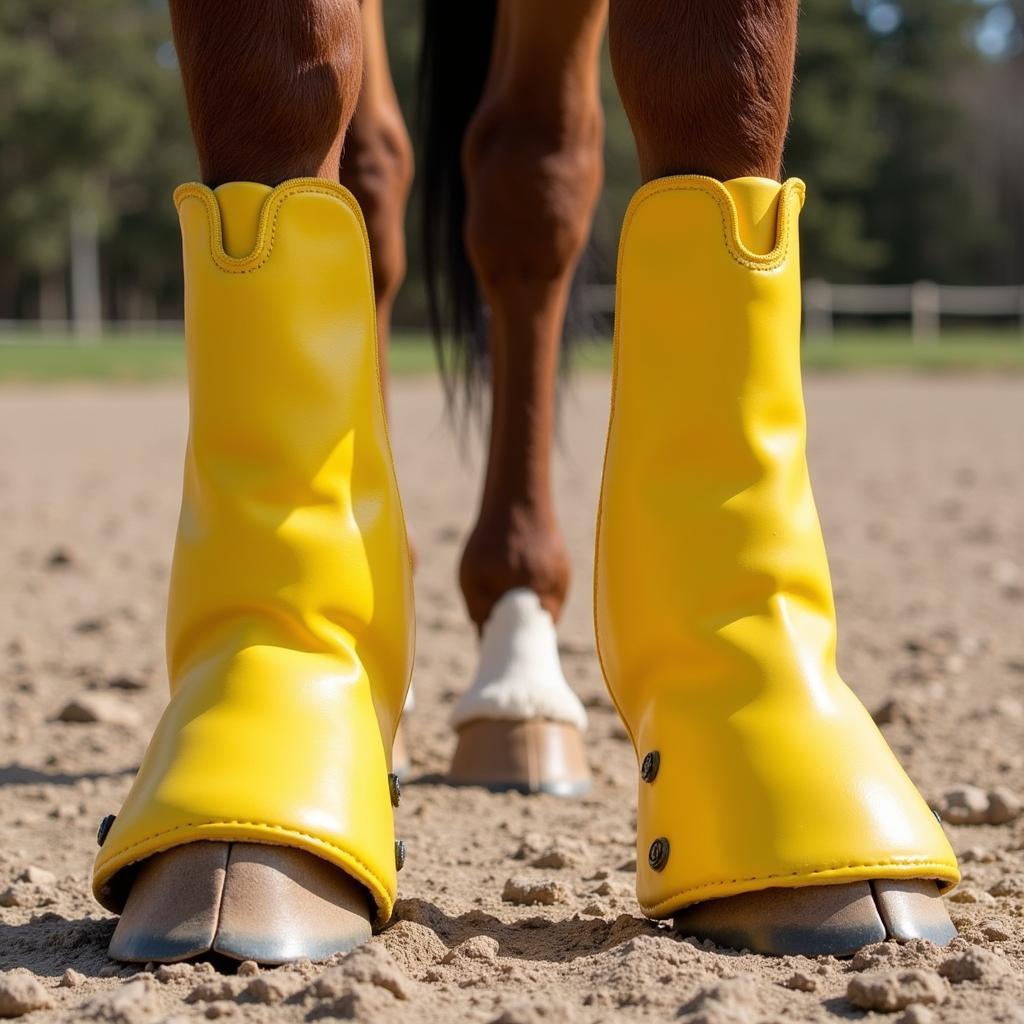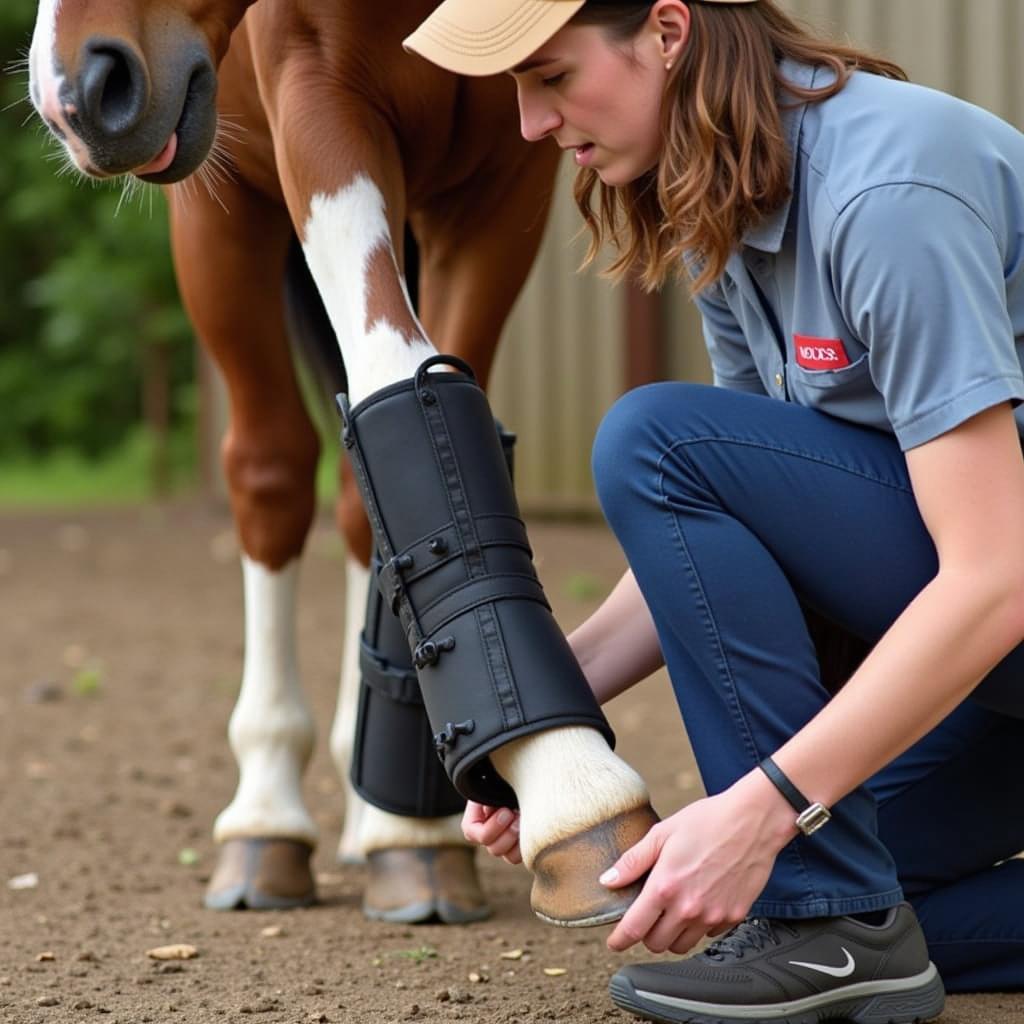Bell boots, also known as overreach boots, are a common piece of protective gear used by horse owners to safeguard their equine companions from injuries. These boots get their name from their bell-like shape that covers the horse’s hoof and pastern (the area between the hoof and the fetlock joint). But What Are Bell Boots For Horses Used For exactly? Let’s delve into the world of bell boots and understand their importance in maintaining your horse’s well-being.
 Horse Wearing Bell Boots in Pasture
Horse Wearing Bell Boots in Pasture
Protecting Against Overreaching
One of the primary reasons equestrians use bell boots is to prevent overreaching injuries. Overreaching occurs when a horse’s hind hoof strikes the back of a front hoof, potentially causing cuts, bruises, and even lameness. This is especially common in horses with a long stride or those engaged in activities that involve fast-paced movement, such as jumping or galloping.
 Horse Overreaching During Canter
Horse Overreaching During Canter
Bell boots act as a buffer, cushioning the impact and minimizing the risk of injury. The flared shape of the boot provides extra coverage to the back of the pastern and heel area, which are most vulnerable to overreaching strikes.
Shielding from Interference Injuries
Similar to overreaching, interference occurs when a horse’s hooves strike each other, but in this case, it’s not limited to the hind hoof striking the front. Interference can involve any combination of hooves, often happening during lateral movements or when a horse has conformation issues.
Bell boots can help prevent these types of interference injuries by providing a protective barrier around the hoof. They are particularly beneficial for horses that tend to wing inwards (plaiting) or outwards (paddling) with their legs, as these gaits increase the likelihood of hoof-to-hoof contact.
Supporting Healing and Preventing Further Injury
Beyond preventing initial injuries, bell boots can also be useful for horses recovering from existing wounds or those prone to specific hoof problems. For instance, if a horse has a cut or abrasion on its heel or pastern, a bell boot can help keep the area clean, dry, and protected from further irritation.
 Veterinarian Examining Horse Hoof with Bell Boot
Veterinarian Examining Horse Hoof with Bell Boot
Additionally, horses with conditions like contracted heels or those prone to developing quarter cracks might benefit from wearing bell boots, as the boots can provide support and cushioning to the affected areas, promoting healing and preventing further damage.
Choosing the Right Bell Boots
When selecting bell boots for your horse, it’s essential to choose the right size and material. Ill-fitting boots can rub and cause sores, while boots made from inappropriate materials may not offer adequate protection or breathability.
Consider factors like:
- Size: Measure your horse’s hoof carefully to ensure a snug but not too tight fit.
- Material: Options range from durable rubber to lightweight synthetic materials. Choose a material that suits your horse’s needs and the intended use of the boots.
- Closure Type: Bell boots typically come with Velcro or buckle closures. Velcro offers convenience, while buckles provide a more secure fit, particularly for active horses.
“When choosing bell boots,” advises Dr. Emily Carter, DVM, an equine veterinarian with over 20 years of experience, “prioritize a secure fit and a material that balances protection with breathability. Regularly inspect the boots for wear and tear and replace them when necessary to ensure optimal hoof health.”
Conclusion
Bell boots are a valuable tool for protecting your horse’s hooves and lower legs from a range of potential injuries. By understanding the different uses of bell boots and choosing the right type for your horse, you can help keep your equine partner sound and comfortable, allowing them to perform at their best. Remember, investing in proper hoof care and protective gear is an essential aspect of responsible horse ownership.
FAQs
1. Do horses need to wear bell boots all the time?
No, horses don’t need to wear bell boots all the time. They are primarily necessary during exercise or turnout when the risk of overreaching or interference is higher.
2. Can I leave bell boots on my horse overnight?
It’s generally not recommended to leave bell boots on overnight. Prolonged use can trap moisture and dirt, increasing the risk of skin irritation and hoof problems.
3. How do I clean bell boots?
Most bell boots can be cleaned with soap and water. Rinse them thoroughly and allow them to air dry completely before putting them back on your horse.
4. What are fetlock boots, and how are they different from bell boots?
Fetlock horse boots protect the fetlock joint from impact and interference, often used in jumping disciplines. Unlike bell boots that focus on hoof protection, fetlock boots cover the area just above the hoof.
5. What other protective gear might my horse need?
Depending on your horse’s discipline and individual needs, you might consider other gear like horse tack english, horses gear, or dress up for horses alongside bell boots.
6. What are some common signs of an overreaching injury?
Look for cuts, bruises, or swelling on the back of the front hooves or the front of the hind hooves. Lameness or a change in gait can also indicate an injury.
7. Where can I learn more about caring for my horse’s hooves?
Visit the horse riding boot section of our website for more resources on hoof care and other equestrian needs.
For any questions or assistance in selecting the right bell boots for your horse, don’t hesitate to reach out to us at Phone Number: 0772127271, Email: [email protected], or visit us at QGM2+WX2, Vị Trung, Vị Thuỷ, Hậu Giang, Việt Nam. Our dedicated customer support team is available 24/7 to assist you.